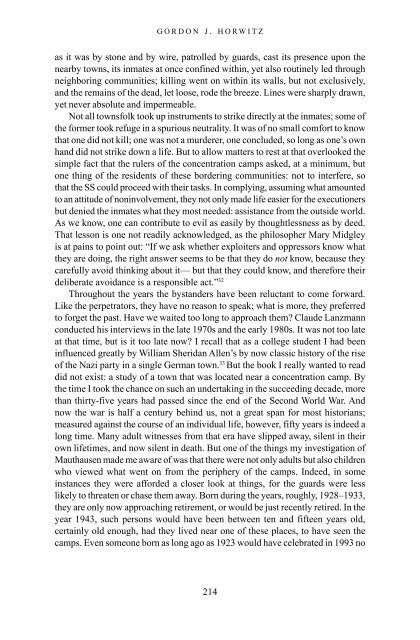The_Holokaust_-_origins,_implementation,_aftermath
The_Holokaust_-_origins,_implementation,_aftermath
The_Holokaust_-_origins,_implementation,_aftermath
Create successful ePaper yourself
Turn your PDF publications into a flip-book with our unique Google optimized e-Paper software.
GORDON J. HORWITZ<br />
as it was by stone and by wire, patrolled by guards, cast its presence upon the<br />
nearby towns, its inmates at once confined within, yet also routinely led through<br />
neighboring communities; killing went on within its walls, but not exclusively,<br />
and the remains of the dead, let loose, rode the breeze. Lines were sharply drawn,<br />
yet never absolute and impermeable.<br />
Not all townsfolk took up instruments to strike directly at the inmates; some of<br />
the former took refuge in a spurious neutrality. It was of no small comfort to know<br />
that one did not kill; one was not a murderer, one concluded, so long as one’s own<br />
hand did not strike down a life. But to allow matters to rest at that overlooked the<br />
simple fact that the rulers of the concentration camps asked, at a minimum, but<br />
one thing of the residents of these bordering communities: not to interfere, so<br />
that the SS could proceed with their tasks. In complying, assuming what amounted<br />
to an attitude of noninvolvement, they not only made life easier for the executioners<br />
but denied the inmates what they most needed: assistance from the outside world.<br />
As we know, one can contribute to evil as easily by thoughtlessness as by deed.<br />
That lesson is one not readily acknowledged, as the philosopher Mary Midgley<br />
is at pains to point out: “If we ask whether exploiters and oppressors know what<br />
they are doing, the right answer seems to be that they do not know, because they<br />
carefully avoid thinking about it— but that they could know, and therefore their<br />
deliberate avoidance is a responsible act.” 32<br />
Throughout the years the bystanders have been reluctant to come forward.<br />
Like the perpetrators, they have no reason to speak; what is more, they preferred<br />
to forget the past. Have we waited too long to approach them Claude Lanzmann<br />
conducted his interviews in the late 1970s and the early 1980s. It was not too late<br />
at that time, but is it too late now I recall that as a college student I had been<br />
influenced greatly by William Sheridan Allen’s by now classic history of the rise<br />
of the Nazi party in a single German town. 33 But the book I really wanted to read<br />
did not exist: a study of a town that was located near a concentration camp. By<br />
the time I took the chance on such an undertaking in the succeeding decade, more<br />
than thirty-five years had passed since the end of the Second World War. And<br />
now the war is half a century behind us, not a great span for most historians;<br />
measured against the course of an individual life, however, fifty years is indeed a<br />
long time. Many adult witnesses from that era have slipped away, silent in their<br />
own lifetimes, and now silent in death. But one of the things my investigation of<br />
Mauthausen made me aware of was that there were not only adults but also children<br />
who viewed what went on from the periphery of the camps. Indeed, in some<br />
instances they were afforded a closer look at things, for the guards were less<br />
likely to threaten or chase them away. Born during the years, roughly, 1928–1933,<br />
they are only now approaching retirement, or would be just recently retired. In the<br />
year 1943, such persons would have been between ten and fifteen years old,<br />
certainly old enough, had they lived near one of these places, to have seen the<br />
camps. Even someone born as long ago as 1923 would have celebrated in 1993 no<br />
214



